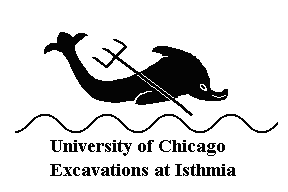UNIVERSITY OF CHICAGO EXCAVATIONS AT ISTHMIA, 2006
SITE and MUSEUM: The site and museum are undergoing renovation through a grant from the European Fund for Rural Improvements and Third Community Support Budget. The project is administered by the Λ Ζ (37th) Ephoreia of Prehistoric and Classical Antiquities of the Hellenic Ministry of Culture under the direction of the ephor, Alexander Mantis, archaeologist, Vassilios Tassinos, and architect, Maria Kechrinioti (Figure 1).
 |
 |
| Figure 1: Maria Kechrinioti and Vassilios Tassinos. | Figure 2: New walkway on the site. |
New walkways lead visitors across the south side of the sanctuary (Figure 2), a roped barrier protects sensitive areas, the Palaimonion passage has been covered (Figure 3), and descriptive plaques now inform visitors about the major monuments (Figure 1). In the storage area a state-of-the-art sealed chamber holds the Kenchreai glass panels. We look forward to the site and museum opening next year.

Figure 3: Structure for covering the Palaimonion passage.
CONFERENCE: “Half a Century on the Isthmus: A conference to celebrate over fifty years of excavation and survey on the Isthmus of Corinth” is planned for 15-17 June 2007 in Cotsen Hall at the American School of Classical Studies in Athens.
Archaic Temple: Fritz Hemans, Niki Hemans, Jonathan Stevens
Wall blocks: The variable angle in the bevel of the anathyrosis, 85-88 degrees, suggests (with detailed examination of the front surface of the blocks) that saws were not used. Columns: Study of the fragments from Doric columns that may have been used in the pronaos shows that they had a maximum lower diameter of ca. 0.55 m. It is likely that the columns of the colonnade were similar in size, less than Oscar Broneer’s estimate of ca. 0.70. They suggest a height of around 3.3 m based on a proportion of ca. 1:6. Fragments from fluted pilasters are oval in shape and may have been added to the walls during a renovation to the temple.
Late Archaic and Classical ceramics: Martha Risser, Joe Ricci
Large Circular Pit (reservoir): Analysis was continued of vessels for transporting foodstuffs into the sanctuary, short-term storage of food and drink, meal preparation, serving and consumption (see 2005 report). It appears that the vessels were not intended for one-time use. Instead, those that were still serviceable were collected and stored for the next festival. The supply was supplemented with new sets as needed.
The Rachi Settlement: Virginia Anderson-Stojanovic, Jonathan Stevens
Final drawings and checking of data were completed. It became clear that Houses IV, V, VI in such a small area was not convincing. A new reconstruction of only two houses, IV and V, creates a more natural plan. The extensive development on the south side of the ridge was documented, including a large terrace wall, ramp and steps leading up to the northeast, and floors, niches, and beam holes cut in the bedrock between Houses IX and X.
Late Hellenistic and Roman ceramics John Hayes
The completed manuscript is in the hands of the director and project editor.
Palaimonion Elizabeth Gebhard, Jonathan Stevens, Fritz Hemans
In the first century A.D. the abandoned reservoir and manhole of the Early Stadium were interpreted as the tomb of the hero Melikertes-Palaimon. When the system was incorporated into the base of his temple, the original connection with the stadium was lost. (Figure 3). Restored drawings were made of the manhole and reservoir as it existed during the first century of Roman cult activity.
Studies continued on:
Arms and armor: Alastar Jackson, Irena Marszalek
Worked stone objects: Ivan Gatsov, Petranka Nadelzheva
Storage of Context pottery from the University of Chicago and Indiana University Excavations at Kenchreai, 1963-1970 Jean Perras, Nicholas Didaskalos, A. Papaioannou, and students of Joe Rife from Macalester University.
At the request of Alexander Mantis the Isthmia Excavations repacked the un-inventoried pottery from Kenchreai in plastic containers. Context information from the original cardboard boxes was printed on labels and entered in a computer database. (Figure 4)

Figure 4: Storage at the Isthmia Museum.

